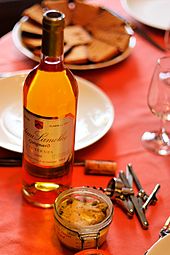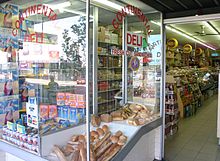| Revision as of 05:48, 14 November 2024 editSharnadd (talk | contribs)Extended confirmed users515 edits SpacingTags: Reverted Visual edit Mobile edit Mobile web edit← Previous edit | Revision as of 05:49, 14 November 2024 edit undoSharnadd (talk | contribs)Extended confirmed users515 edits Corrected wordTags: Reverted Visual edit Mobile edit Mobile web editNext edit → | ||
| Line 19: | Line 19: | ||
| The first delicatessen to appear in England was L Teroni and sons. This was opened by Queen Victoria in 1878. It is still open today but is no longer run by the same family. | The first delicatessen to appear in England was L Teroni and sons. This was opened by Queen Victoria in 1878. It is still open today but is no longer run by the same family. | ||
| == The |
== The Country and region == | ||
| {{see also|List of delicatessens}} | {{see also|List of delicatessens}} | ||
| {{More citations needed|section|date=June 2021}} | {{More citations needed|section|date=June 2021}} | ||
Revision as of 05:49, 14 November 2024
Shop selling cured meats and sausages, expensive cheeses, caviar, or luxury confectionery For other uses, see Delicatessen (disambiguation). "Deli" redirects here. For other uses, see Deli (disambiguation).

Traditionally, a delicatessen or deli is a grocery that sells a selection of fine, exotic, or foreign prepared foods. Delicatessens originated in Germany (original: Delikatessen) during the 18th century and spread to the United States in the mid-19th century. European immigrants to the United States, especially Ashkenazi Jews, popularized the delicatessen in U.S. culture beginning in the late 19th century. Today, many large retail stores like supermarkets have deli sections.
Etymology

Delicatessen is a German loanword which first appeared in English in the late 19th century and is the plural of Delikatesse. The German form was lent from the French délicatesse, which itself was lent from Italian delicatezza, from delicato, of which the root word is the Latin adjective delicatus, meaning "giving pleasure, delightful, pleasing". The first U.S. short version of this word, deli, came into existence probably after World War II with the first evidence being from 1948.
History
The origin of the delicatessen as a grocery store is lost in time, but the path clearly spread across Western Europe as the term was borrowed by one people and language and culture after another.
The German food company Dallmayr traces its history to 1700, when it became the first store to import to the German population bananas, mangoes, and plums from places such as the Canary Islands and China. Over 300 years later, it remains the largest business of its kind in Europe.
The first delicatessen to appear in England was L Teroni and sons. This was opened by Queen Victoria in 1878. It is still open today but is no longer run by the same family.
The Country and region
See also: List of delicatessens| This section needs additional citations for verification. Please help improve this article by adding citations to reliable sources in this section. Unsourced material may be challenged and removed. Find sources: "Delicatessen" – news · newspapers · books · scholar · JSTOR (June 2021) (Learn how and when to remove this message) |
Australia

In most of Australia, the term "delicatessen" retains its European meaning of high-quality, expensive foods and stores. Large supermarket chains often have a deli department, and independent delicatessens exist throughout the country. Both types of deli offer a variety of cured meats, sausages, pickled vegetables, dips, breads, and olives.
In South Australia and Western Australia, "deli" also denotes a small convenience store or milk bar, and some businesses use "deli" as part of their business name. Traditional delicatessens also exist in these states, with "continental delicatessen" sometimes used to indicate the European version.
Canada
In Canada, both meanings of "delicatessen" are used. Customers of European origin often use the term in a manner consistent with its original German meaning, but as in the United States, a deli can be a combined grocery store and restaurant.
Europe

In Europe "delicatessen" means high-quality, expensive foods, and stores. In German-speaking countries a common synonym is Feinkost (fine food), and shops that sell it are called Feinkostläden (delicacy stores). Department stores often have a Delikatessenabteilung (delicacy department). European delicatessens include Fauchon in Paris, Dallmayr in Munich, Julius Meinl am Graben in Vienna, Harrods and Fortnum & Mason in London, Peck in Milan, and Jelmoli in Zürich.
Although U.S.-style delicatessens are also found in Europe, they appeal to the luxury market. In Russia, shops and supermarket sections approximating U.S.-style delis are called kulinariya and offer salads and main courses. Delicate meats and cheeses, cold-cut and sliced hot, are sold in a separate section. The Eliseevsky food store in central Moscow, with its fin de siècle decor, is similar to a European delicatessen. From the Tsarist era, it was preserved by the Soviets as an outlet for difficult-to-obtain Russian delicacies. Delicatessens may also provide foods from other countries and cultures that are not readily available in local food stores. In Italy, the deli can be called gastronomia, negozio di specialità gastronomiche, bottega alimentare and more recently salumeria. In France it is known as a traiteur or épicerie fine.
Ireland
In Ireland, a "deli" or "deli counter" is a food counter serving pre-prepared "food to go" like sandwiches and hot snacks. This trend began in the 1990s and led to the emergence of many ready-to-eat deli products. Delis can be found at a wide variety of convenience shops, newsagents, supermarkets, petrol stations, and casual eateries throughout Ireland.
Popular items served at hot deli counters include chicken fillet rolls (breaded chicken fillet on a bread roll), breakfast rolls (Irish breakfast items on a bread roll), jambons, sausage rolls, and potato wedges.
United States
| This section needs additional citations for verification. Please help improve this article by adding citations to reliable sources in this section. Unsourced material may be challenged and removed. (December 2022) (Learn how and when to remove this message) |

In the United States, a delicatessen (or deli) can be a simple retail grocery store, a sit-down restaurant, or any combination in between. Sit-down and to-go delis offer a broader, fresher menu than fast-food chains, rarely employing fryers (except for chicken) and routinely preparing sandwiches to order. Delicatessens from a number of cultures can be found in the United States, including Italian, Greek, and Jewish, both kosher and "kosher style". The American equivalent of a European delicatessen may be known as a gourmet food store.
Retail delis in the U.S. sell fresh-sliced cold cuts and cheeses. In addition to made-to-order sandwiches, many American delicatessens offer made-to-order green salads. Prepared pasta, potato, chicken, and tuna salads, or other salads are sometimes displayed under the counter and sold by weight. This is the same as a deli counter in a supermarket in the UK. Precooked chicken, shrimp, or eggplant dishes may also be sold. Some establishments have table seating for patrons to consume sandwiches and other food, while others only sell food to go. Delicatessens offer a variety of beverages, such as pre-packaged or fountain soft drinks, bottled water, coffee, tea, and milk. Potato chips and similar products, newspapers, and small items such as candy and mints are also usually available.
See also
- Appetizing store
- Charcuterie
- Delicacy
- List of delicatessens
- Jewish deli
- Osteria
- Pastrami on rye
- Salumeria
- Salumi
- Save the Deli – a book about the decline of the Jewish delicatessen
- Specialty foods
- Traiteur
- Trattoria
References
- ^ "Deli". U.S. Heritage Dictionary. Retrieved 18 September 2021.
- "Deli". merriam-webster.com. Merriam-Webster. Retrieved 16 April 2016.
- "Step by step to success". www.dallmayr.com. Archived from the original on 5 October 2015. Retrieved 5 October 2015.
- History of New York Delis (Report). pastramiblog.blogspot.com. 2009. Retrieved 16 April 2016.
- "Are pork scratchings going posh? - BBC News". BBC News. 20 June 2015. Retrieved 11 April 2016.
- "Delicatessens in Knightsbridge, Central London | Reviews – Yell". Trustedplaces.com. Archived from the original on 5 October 2008. Retrieved 7 October 2015.
- ^ Devery, Caitriona (27 October 2020). "Mysteries of the Deli: The Jambon". District Magazine. Retrieved 7 April 2021.
- McWilliams, David (22 October 2009). David McWilliams' Follow the Money: David McWilliams Ireland 2. Gill & Macmillan Ltd. ISBN 9780717155576 – via Google Books.
- Anderson, Heather Arndt (11 July 2013). Breakfast: A History. AltaMira Press. ISBN 9780759121652 – via Google Books.
- McWilliams, David (11 January 2011). The Pope's Children: The Irish Economic Triumph and the Rise of Ireland's New Elite. John Wiley & Sons. ISBN 9781118045374 – via Google Books.
- Brent, Harry (8 October 2020). "Ireland's favourite deli food has been revealed - and it's hardly a surprise". The Irish Post. Retrieved 11 January 2022.
- McDonald, Brian (12 May 2008). "Top breakfast baguette rolls into Irish history". Irish Independent. Retrieved 3 February 2019.
Further reading
- Merwin, Ted. Pastrami on Rye: An Overstuffed History of the Jewish Deli (New York University Press, 2015.) xviii, 245 pp.